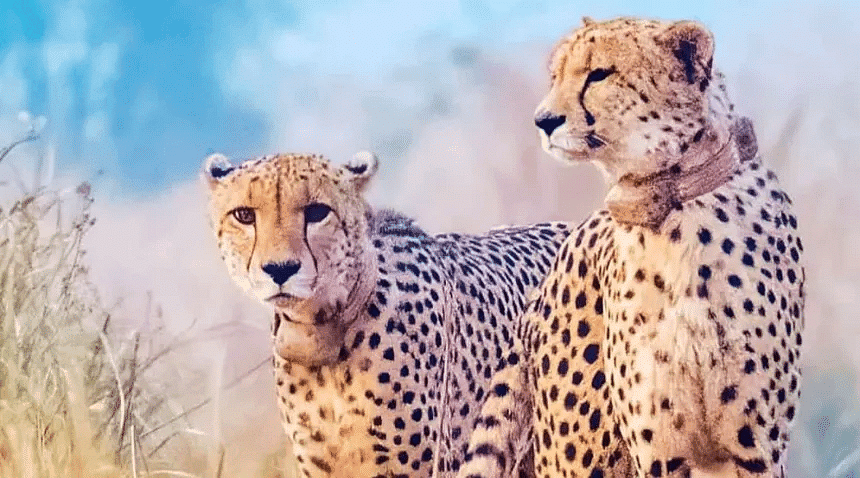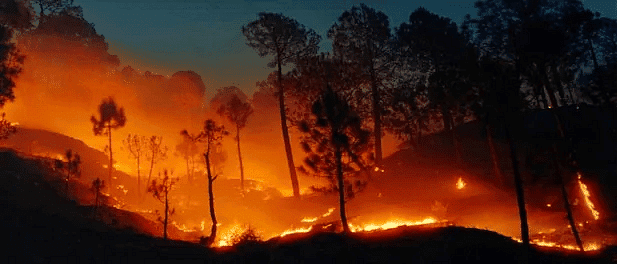Environment & Ecology - 5 | Current Affairs & Hindu Analysis: Daily, Weekly & Monthly - UPSC PDF Download
Alligator Gar Fish

Context
- Discovery of alligator gar, a non-native predator fish mostly found in North America, in Srinagar’s Dal Lake surprised experts in Kashmir.
About the fish
- Scientific Name: Atractosteus spatula
- It resembles a crocodile and is classified under the catfish family.
- Alligator gars are indigenous to North America and feed on other fish, but have been found in other areas after their accidental introduction in waterbodies.
- Usually, they don’t attack humans, but they can grow up to eight feet and can be dangerous to indigenous fish species.
Description
- Gars are easily distinguished from other freshwater species by their long, slender, cylindrical bodies, long snouts, and diamond-shaped interlocking (ganoid) scales.
- Alligator gar is the largest of the gar species.
- It can grow up to 8 feet long and weigh more than 300 pounds.
- Adults have two rows of large teeth on either side of the upper jaw. Coloration is generally brown or olive above and lighter underneath.
- The species name spatulais Latin for "spoon", referring to the creature's broad snout.
- Alligator gar can live for many decades.
Distribution
- Alligator gar are present in the Gulf coastal plain from the Econfina River in Florida west and south to Veracruz, Mexico.
- The historic range extends north in the Mississippi River basin to the lower reaches of the Missouri and Ohio rivers.
South Indian Cicada Species Gets a New Identity

Context
- An insect cicada species, which is commonly found in South India, has assumed an Indian identity in light of the finding of a new study.
- Earlier it was known as Purana tigrina and since 1850 was considered to be of Malaysian origin.
- It is now named as Purana cheeveeda (after its Malayalam name Cheeveedu).
Other Details
- The Association for Advancement in Entomology has now corrected the taxonomic identification and classification of this species.
- Earlier cicada found in the region was considered as the Malaysian species owing to the superficial similarities of these species such as –
- Colouration
- morphology
Findings of the study/research
- A team of researchers was led by Kalesh Sadasivan, a research associate of Travancore Nature History Society.
- While documenting cicadas, it found differences in the structure of the male genitalia & operculum.
- Morphological characteristics differences were found.
- They compared the specimens to the holotype and specimen of P. tigrina from Malaya.
Significance of this study
- Enriching and identifying biodiversity of the
- More accurate classification of taxonomy of this
- More efforts to understand the distinct features of this species for better conservation.
- It will also help in the impact of decline of this incest on deteriorating quality of soil and vegetation.
- It also implies a high degree of endemism.
Distribution
- Mainly found in Malabar, Travancore and Malaya regions of South India.
- It can also be believed to be found across the tropical evergreen forests ranging from Goa to Kanyakumari.
Cicada
- These are hemipteran insects, also known as true bugs, belonging to the superfamily of Cicadoidea.
- There are more than 3,000 known species of cicadas.
- Most diversity of this species is found in Indian and neighbouring country Bangladesh.
Features
- These generally have two pairs of membranous wings and prominent compound eyes.
- The length is in range of 2 to 5 cm (0.8 to 2 inches).
- They produce loud, high-pitched buzzing sounds during hot weather.
- These are generally found on large trees in natural forests.
- They also occur in deserts, grasslands.
Usefulness of Cicdas
- They help in aerating the soil.
- They are used in folk medicines.
- In some regions they act as religious and monetary symbols.
- This species is an indicator of soil health and vegetation.
- The dead body acts as a nutrient source, nitrogen to be specific, which helps in growth of the plants.
- In some community is an important source of food.
Threats
- Deforestation due to construction activities.
- Frequent natural or human induced forest fires.
- It is also captured for food and medicine purpose
Project Cheetah and Radio Collar Infections

Context
Recently, the use of radio collars in the cheetah reintroduction project in Kuno Wildlife Sanctuary, Madhya Pradesh, India, has resulted in unexpected setbacks, with cheetahs experiencing neck wounds and septicaemia, an infection of the blood by bacteria.
- This situation has raised concerns among experts familiar with collaring practices in India and Africa.
What are Radio Collars?
- About:
- Radio collars are used to track and monitor animals in the wild.
- They consist of a collar with a small radio transmitter.
- Collars provide data on animal behavior, migration, and population dynamics.
- They can be combined with GPS or accelerometers for additional information.
- Collars are designed to be lightweight and comfortable for animals.
- Potential risks and challenges, such as injuries or infections, must be managed.
- Challenges Associated with Radio Collars:
- Festering Neck Wounds and Septicaemia:
- Two cheetahs in Kuno died due to suspected septicaemia caused by festering neck wounds from radio collars.
- Additional cheetahs, including Oban, Elton, and Freddie, have exhibited similar injuries.
- These setbacks have raised concerns about the use of radio collars in the cheetah reintroduction project.
- Two cheetahs in Kuno died due to suspected septicaemia caused by festering neck wounds from radio collars.
- Problems with Long-term Collar Usage:
- Carrying something on the body for an extended period can have downsides, as seen in studies on watch wearers and pet dogs.
- Staphylococcus aureus bacteria presence was higher on watch wearers' wrists, which can lead to sepsis or death.
- Dogs wearing collars can develop acute moist dermatitis or hot spots, aggravated by ticks or fleas.
- Tight-fitting collars can cause pressure necrosis and rapid hair loss around the neck, similar to bedsores.
- Weight Considerations:
- Globally, the general guideline is to keep radio collar weight below 3% of the animal's body weight.
- Modern collars for wild cats typically weigh around 400g, which is suitable for cheetahs weighing between 20 kg and 60 kg.
- However, fitting collars on cheetahs can be challenging due to their small necks, especially for younger animals.
- Vulnerability to Collar-Induced Injuries:
- Cheetahs' winter coat, which is thicker and furrier than that of tigers or leopards, can retain more water and take longer to dry.
- In a 2020 study, the collar weight rule was criticized for not considering animal athleticism, revealing that collar forces can surpass the collar's weight during movement.
- For instance, the forces exerted by collars were found to be generally equivalent to up to five times the collar’s weight for a lion and a staggering 18 times for a cheetah.
- African Cheetahs may be more susceptible to local pathogens compared to Indian tigers and leopards, potentially due to differences in immunity and environmental conditions.
- Lack of Adaptation to Monsoon Conditions:
- Secondary bacterial infections under collars are not commonly reported in African conditions due to drier skin between rain spells.
- In historical times, cheetahs in India did not wear collars during the monsoon and may have adapted differently to the local climate.
- Implications for the Reintroduction Project:
- Tracking, immobilizing, and assessing cheetahs for neck injuries poses challenges and potential delays.
- The absence of a clear roadmap for the next monsoon raises questions about re-collaring cheetahs and their well-being.
- Festering Neck Wounds and Septicaemia:
What is Cheetah Reintroduction Project in India?
- About:
- The Cheetah Reintroduction Project in India formally commenced on September 17, 2022, with the objective of restoring the population of cheetahs, which were declared extinct in the country in 1952.
- The project involves the translocation of cheetahs from South Africa and Namibia to Kuno National Park in Madhya Pradesh.
- Reintroduction Process:
- 20 radio-collared cheetahs were translocated from South Africa (12 cheetahs) and Namibia (8 cheetahs) to Kuno National Park.
- In March 2023, India announced the birth of 4 cubs to one of the eight cheetahs that were relocated from Namibia.
- The cheetahs underwent a quarantine period and were then shifted to larger acclimatization enclosures.
- Currently, there are 11 cheetahs in free-ranging condition and 5 animals, including a cub, in quarantine enclosures.
- Dedicated monitoring teams ensure round-the-clock monitoring of the free-ranging cheetahs.
- 20 radio-collared cheetahs were translocated from South Africa (12 cheetahs) and Namibia (8 cheetahs) to Kuno National Park.
- Mortalities:
- 8 cheetahs have died in Kuno National Park due to natural causes.
- Preliminary analysis by the National Tiger Conservation Authority (NTCA) indicates that the deaths were natural and not related to other factors like radio collars.
- Project Implementation and Challenges:
- The project is implemented by the NTCA in collaboration with the Madhya Pradesh Forest Department, Wildlife Institute of India (WII), and cheetah experts from Namibia and South Africa.
- Challenges in the project include monitoring, protection, and management of the reintroduced cheetah population.
- Conservation Efforts and Measures:
- Consultation with international cheetah experts and veterinary doctors from South Africa and Namibia is ongoing to investigate the cause of cheetah deaths.
- Independent national experts are reviewing monitoring protocols, protection status, managerial inputs, veterinary facilities, training, and capacity building.
- Efforts are underway to establish a Cheetah Research Center, expand forest areas under Kuno National Park's administrative control, provide additional frontline staff, establish a Cheetah Protection Force, and create a second home for cheetahs in Gandhi Sagar Wildlife Sanctuary.
- The government is committed to conserving the reintroduced cheetah population and ensuring its long-term success.
Saltpan Workers of Little Rann of Kutch

Context
India Meteorological Department (IMD) has recently launched the Heat Index on experimental basis.
- The heat index, also known as the apparent temperature, is what the temperature feels like to the human body when relative humidity is combined with the air temperature.
- Launched by - India Meteorological Department (IMD)
- Aim - To provide general guidance for the regions within India where, the apparent temperature/feel like temperature are on the higher side causing discomfort for the people.
- Ministry – Ministry of Earth Sciences
- A severe heatwave is declared when the temperature is above 40 degrees Celsius and 6.5 degrees above normal.
- The map is plotted by taking into account the forecast temperatures and humidity values of different places at 2.30pm, when the heat is usually at its peak.
- The higher the humidity, the higher the heat index.
- It is important to factor in humid heat, even more so than dry heat, as there is loss of life even at lower temperatures when humidity is high.
- At present, heat index is derived using the heat index equation similar to what is used by National Weather Service, National Oceanic and Atmospheric Administration (NOAA), USA.
Kanwar Yatra
The kanwar Yatra that attracts million of devotees of shiva in state of Uttarakhand had concluded recently.
- The Kanwar Yatra is a pilgrimage organised in the Hindu calendar month of Shravana (Saavan), usually from July to August.
- During this yatra, millions of devotees of Lord Shiva known as 'Kanwariya' make a journey to Haridwar, Gangotri, and Gaumukh in the state of Uttarakhand.
- The water is used by the pilgrims to worship Shiva lingas at shrines of importance, including the 12 Jyotirlingas, or at certain specific temples or even in the devotee’s own village or town.
- In the Gangetic plains, the water is taken from pilgrimage sites such as Haridwar, Gaumukh and Gangotri in Uttarakhand, Sultanganj in Bihar, and Prayagraj, Ayodhya or Varanasi from Uttar Pradesh.
- Similarities - Kanwar yatra in North India is celebrated as Kavadi festival in Tamil Nadu in which Lord Muruga is worshipped.
- Mythology - The ritual goes back to the ‘samudra manthan’, narrated in the Bhagavata Purana and in the Vishnu Purana, which explains the origin of ‘amrita’, or the nectar of immortality.
- Another origin story of the Kanwar yatra is linked with Lord Parashuram, a devotee of Shiva.
NASA's DIMPLE Instrument
NASA selects Artemis instrument – DIMPLE to study Irregular Mare Patch on the Moon.
- DIMPLE – Refers to “Dating an Irregular Mare Patch with a Lunar Explorer” scientific payload.
- Aim - To establish the age and composition of hilly terrain created by volcanic activity on the near side of the Moon.
- Agency – NASA, USA
- Program - It travels to the Moon as a part of Artemis program.
- DIMPLE is accepted through NASA’s Payloads and Research Investigations on the Surface of the Moon (PRISM) program via the Commercial Lunar Payload Services (CLPS) initiative.
- It will investigate the Irregular Mare Patch, (smooth, rounded, slightly mounded areas on the Moon) discovered in 1971 by Apollo 15 orbital images.
- The mission will use a rover, a collection instrument and a spectrometer that can determine the composition of lunar material.
- Significance – Dimple will add to a growing body of knowledge about the Moon, which in turn helps us understand the origins of Earth and other planets in the solar system.
- Additionally, the more we understand about our closest neighbor, the more we can support long-term human exploration at the Moon, and someday, Mars.
Commercial Lunar Payload Services (CLPS) initiative
- This initiative allows rapid acquisition of lunar delivery services from American companies for payloads that advance capabilities for science, exploration or commercial development of the Moon.
- Under Artemis, commercial deliveries beginning in 2022 will perform science experiments, test technologies and demonstrate capabilities to help NASA explore the Moon and prepare for human missions.
Agariyas of Kutch
A group of saltpan workers requested Gujarat Chief Minister for state intervention over forest department officials issuing instructions barring their entry in the Little Rann of Kutch.
- Agariyas - Agariyas are socially recognized as “Chunvaliya Koli” “Miyana” “Sandhi” community all of them fall into De-notified tribe (NTDNT) category.
- In their language, agar means salt and those who farm it are called Agariyas.
- Salt production - Coastal salt is called as “Sea Salt” locally known as “karkacch salt” where in Little Rann of Kutch Agariyas make crystal salt called “Vadagaru” or “Poda”.
- Current issue - The forest department wants the Agariyas to leave the Little Rann but the Agariyas are pacifists who do not in any way harm the endemic wild asses that number some 5,000.
Kutch
- Kutch is a district of Gujarat state.
- The Rann is known for its marshy salt flats which become snow white after the shallow water dries up each season before the monsoon rains.
- The district is also known for ecologically important Banni grasslands with their seasonal marshy wetlands which form the outer belt of the Rann of Kutch.
- Kutch is an island, as it is surrounded by the Arabian Sea in the west and the Gulf of Kutch in south and southeast.
- The northern and eastern parts are surrounded by the Great and Little Rann (seasonal wetlands) of Kutch.
- The entire Little Rann was notified as a wildlife sanctuary in 1973 and, since 2006, exists inside a wild ass sanctuary.
Indian Wild Ass
- The Indian Wild Ass is a species of ass that is native to the countries of southern Asia.
- It is one of the 4 remaining subspecies of the Asian Wild Ass, and it can only be found in India.
- Local terms - Ghudkhur, Khur, or Indian onager.
- The Indian Wild Ass, in contrast to its closely related family of donkeys and horses, has not been domesticated.
- Habitat - These species live in a variety of habitats including wetland ecosystems, deserts, arid grasslands and shrub lands.
- They are currently only found in small numbers in India's Rann of Kutch region.
- IUCN Status - Near Threatened.
X-ray Auroras
During a close Mercury flyby, the BepiColombo spacecraft collected data that showed how electrons raining down on the planet's suface are triggering X-ray auroras.
- Auroras - An aurora is a natural colourful light display that shimmers in the sky.
X-ray Auroras in Mercury
- High energy electrons from the solar wind rain down on Mercury's surface and, because they are not restricted by a thick atmosphere, they hit the surface.
- This process emits an auroral glow in the form of X-rays.
- For the first time, scientists have witnessed how electrons are accelerated in Mercury’s magnetosphere and precipitated onto the planet’s surface.
- MESSENGER Mission- Aurorae at Mercury had previously been observed by the MESSENGER mission, but the exact processes that cause the x-ray aurora had not been well understood.
- Mercury’s magnetosphere is much smaller than Earth’s and has a different structure and dynamics, that is evident that generates aurorae is the same throughout the Solar System.
- BepiColombo is a joint mision by the European Space Agency (ESA) and the Japanese Aerospace Exploration Agency (JAXA).
Ludwigia peruviana Threatens Elephant Habitats in Tamil Nadu
Context
- Ludwigia peruviana is an invasive aquatic weed originally native to Central and South America, including Peru.
- It has become a serious threat to elephant habitats in Valparai, a hill station in Tamil Nadu, located near the Kerala border.
Details
Rapid Spread and Impact
- Ludwigia peruviana grows rapidly along water bodies, particularly in the swamps, locally known as vayals, of Valparai.
- These swamps were once lush with grass and native plants, providing vital foraging areas for elephants, even during dry months.
- However, the rapid spread of Ludwigia has disrupted this balance, limiting the growth of edible grasses and plants, affecting the food supply for elephants and other herbivores like gaur.
Human-Elephant Conflict Risk
- As the invasive weed displaces the natural forage in elephant habitats, there is an increased risk of human-elephant conflicts.
- Elephants may venture closer to human settlements in search of alternative food sources, leading to potential confrontations and safety concerns for both humans and elephants.
Impact on Elephant Habitats in Annamalai Tiger Reserve
- Valparai is situated within the larger Annamalai Tiger Reserve, a critical area for the conservation of elephants that traverse between Tamil Nadu and Kerala.
- The invasion of Ludwigia in Valparai's swamps has disrupted the ecological balance and traditional movement patterns of elephants within the reserve.
- Elephant habitats are essential for the sustenance of the pachyderms and contribute to maintaining the overall biodiversity of the region.
Conservation Efforts and Challenges
- The spread of Ludwigia in Valparai's swamps has raised conservation concerns, prompting efforts to tackle this invasive species.
- Conservationists are calling for a mapping and grading process to assess the severity of Ludwigia invasion, enabling targeted management strategies.
- The removal of Ludwigia presents unique challenges as it predominantly grows in swamps, limiting the use of machinery for eradication without causing further environmental damage.
Role of Private Estates and Government Agencies
- Most of the swamps infested by Ludwigia are situated on private estates, making their active involvement in conservation efforts crucial.
- Under the Tamil Nadu Preservation of Private Forests Act, private estates have a responsibility to engage in conservation activities.
- Government agencies, such as the Forest Department, are collaborating with private estates to address the issue collectively.
Valparai: A Hill Station in Tamil Nadu
Location and Geography
- Valparai is a hill station located in the Coimbatore district of Tamil Nadu, India.
- Situated at an elevation of about 3,500 feet (1,100 meters) above sea level, Valparai is nestled amidst the Western Ghats, a UNESCO World Heritage Site known for its rich biodiversity.
Scenic Beauty and Climate
- Valparai is renowned for its picturesque landscapes, lush tea estates, rolling hills, and dense forests.
- The region experiences a moderate and pleasant climate throughout the year.
Tea Plantations and Biodiversity
- Valparai is known for its extensive tea plantations that cover vast areas of the hill station.
- Apart from tea cultivation, the region boasts diverse flora and fauna due to its location within the Western Ghats biodiversity hotspot.
Wildlife and Conservation
- Valparai is home to various wildlife species, including elephants, gaur, leopards, macaques, and numerous bird species.
- The presence of elephants in the region has led to human-wildlife conflicts, making wildlife conservation efforts crucial.
Annamalai Tiger Reserve
Location and Extent
- The Annamalai Tiger Reserve is situated in the Western Ghats of Tamil Nadu and spans across the Coimbatore and Tiruppur districts.
- It covers an extensive area of about 1,459 square kilometers, making it one of the largest protected areas in the region.
Wildlife Conservation
- The reserve was established primarily to protect the endangered Bengal tiger and its habitat.
- Apart from tigers, the Annamalai Tiger Reserve supports a diverse range of flora and fauna, making it a crucial biodiversity hotspot.
Unique Ecosystems
- The reserve encompasses various ecosystems, including evergreen forests, montane grasslands, shola forests, and swamps, providing a rich and diverse habitat for wildlife.
Conclusion
The invasion of Ludwigia peruviana in Valparai's swamps poses a significant threat to elephant habitats and their natural foraging areas. Swift conservation actions, cooperation between private estates and government agencies, and the active involvement of conservationists are essential to mitigate the impact of this invasive species and ensure the coexistence of humans and elephants in the region. The preservation of these vital habitats is vital for safeguarding the rich biodiversity of Valparai and the ecological balance of the Annamalai Tiger Reserve.
Mhadei Wildlife Sanctuary

Context
Recently, in a significant development for tiger conservation efforts, the Goa bench of the Bombay High Court has issued a directive to the Goa government to notify the Mhadei Wildlife Sanctuary and its surrounding areas as a tiger reserve under the Wildlife Protection Act, 1972 within three months from 24th July 2023.
- The decision comes after a prolonged legal battle and demands from environmentalists and conservationists, and it carries implications for wildlife protection and forest dwellers in the region.
What are the Key Facts about Mhadei Wildlife Sanctuary?
- Location and Landscape:
- Located in the Northern part of Goa, Sanguem taluka, near Valpoi town.
- Encompasses picturesque waterfalls, including Vazra Sakla Falls and Virdi Falls.
- Known for its nesting grounds of critically endangered Long-billed vultures near Vazra Falls.
- Diverse landscape with thick moist deciduous forests and some evergreen species.
- Notable for sacred groves protecting rare and indigenous trees.
- Flora and Fauna
- Rich biodiversity with Indian gaur, Tigers, Barking deer, Sambar deer, Wild boar, Indian hare, and more.
- Attracts herpetologists due to the presence of various snakes, including the 'big four' venomous snakes which are Indian krait, Russell’s viper, Saw-scaled viper and Spectacled cobra.
- Designated an International Bird Area for hosting several bird species like Malabar parakeet and Rufous babbler.
- Represents a crucial habitat for tiger conservation in Goa.
- Unique Geographical Features:
- Home to the three highest peaks in Goa: Sonsogod (1027 mts), Talavche Sada (812 mts), and Vageri (725 mts).
- Mhadei River, a lifeline of Goa, originates in Karnataka, passes through the sanctuary, and meets the Arabian Sea at Panaji.
- The sanctuary acts as a catchment area for the Mhadei River.
|
38 videos|5293 docs|1118 tests
|





















